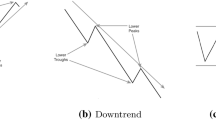Abstract
In this paper Kohonen’s Self Organising Map is used as a tool for detecting changing financial relationships. A Self Organising Map (SOM) is a dimension reducing transform that maps an high dimension information set to a two dimensional grid that is amenable to visualisation. This dimension reduction step is a key component of all financial analysis tasks. The potential of this method to identify structural change is investigated in the context of the problem of takeover target identification. Use of SOM analysis on two samples from different time periods charts temporal instability in the information sets of sufficient magnitude to breach the stationarity assumptions of standard statistical modelling methods, the results are confirmed by probabilistic regression analysis. This finding helps to explain the poor discriminatory power of many takeover target prediction exercises.
Access this chapter
Tax calculation will be finalised at checkout
Purchases are for personal use only
Similar content being viewed by others
Notes
- 1.
Harris et al. (1982) found a predictive model with high explanatory power, which was unable to accurately discriminate between target and non target firms. Palepu (1986) provided evidence that the predictive ability of the logit model he constructed was no better than a chance selection of target and non target firms.
- 2.
Stakeholders are generally considered to be both stock and bond holders of a corporation.
- 3.
We take the interests of shareholders to be in the maximization of the present value of the firm.
References
Altman, E.I.: Financial ratios, corporate bankruptcy. J. Finan. 23, 589–609 (1968)
Barnes, P.: Predicting UK takeover targets: some methodological issues and empirical study. Rev. Quant. Finan. Account. 12, 283–301 (1999)
Jensen, M.C., Meckling, W.H.: Theory of the Firm: Managerial behaviour, agency costs, and ownership structure. J. Finan. Econ. 3, 305–360 (1976)
Manne, H.G.: Mergers and the market for corporate control. J. Polit. Econ. 73, 110–120 (1965)
Fama, E.F.: Agency problems and the theory of the firm. J. Polit. Econ. 88, 288–307 (1980)
Jensen, M.C., Ruback, R.S.: The market for corporate control: the scientific evidence. J. Finan. Econ. 11, 5–50 (1983)
Jensen, M.C.: Agency costs of free cash flow. Corp. Finan. Takeovers, Am. Econ. Rev. 76, 323–329 (1986)
Smith, R.L., Kim, J.-H.: The combined effect of free cash flow and financial slack on bidder and target stock returns. J. Bus. 67, 281–310 (1994)
Myers, S.C., Majluf, N.S.: Corporate financing and investment decisions when firms have information that investors do not. J. Finan. Econ. 13, 187–221 (1984)
Lewellen, W.G.: A pure financial rationale for the conglomerate merger. J. Finan. 26, 521–537 (1971)
Miller, M.H., Modigliani, F.: Dividend policy. Growth, Valuation Shares, J. Bus. 34, 411–433 (1964)
Kohonen, T.: Self-organized formation of topologically correct feature maps. Biol. Cybern. 43, 59–69 (1982)
Allison, P.D.: Logistic Regression Using the SAS System. SAS Institute, Cary, NC (2006)
Author information
Authors and Affiliations
Corresponding author
Editor information
Editors and Affiliations
Rights and permissions
Copyright information
© 2015 Springer International Publishing Switzerland
About this paper
Cite this paper
Peat, M., Jones, S. (2015). Detecting Changing Financial Relationships: A Self Organising Map Approach. In: Lugmayr, A. (eds) Enterprise Applications and Services in the Finance Industry. FinanceCom 2014. Lecture Notes in Business Information Processing, vol 217. Springer, Cham. https://doi.org/10.1007/978-3-319-28151-3_1
Download citation
DOI: https://doi.org/10.1007/978-3-319-28151-3_1
Published:
Publisher Name: Springer, Cham
Print ISBN: 978-3-319-28150-6
Online ISBN: 978-3-319-28151-3
eBook Packages: Computer ScienceComputer Science (R0)




